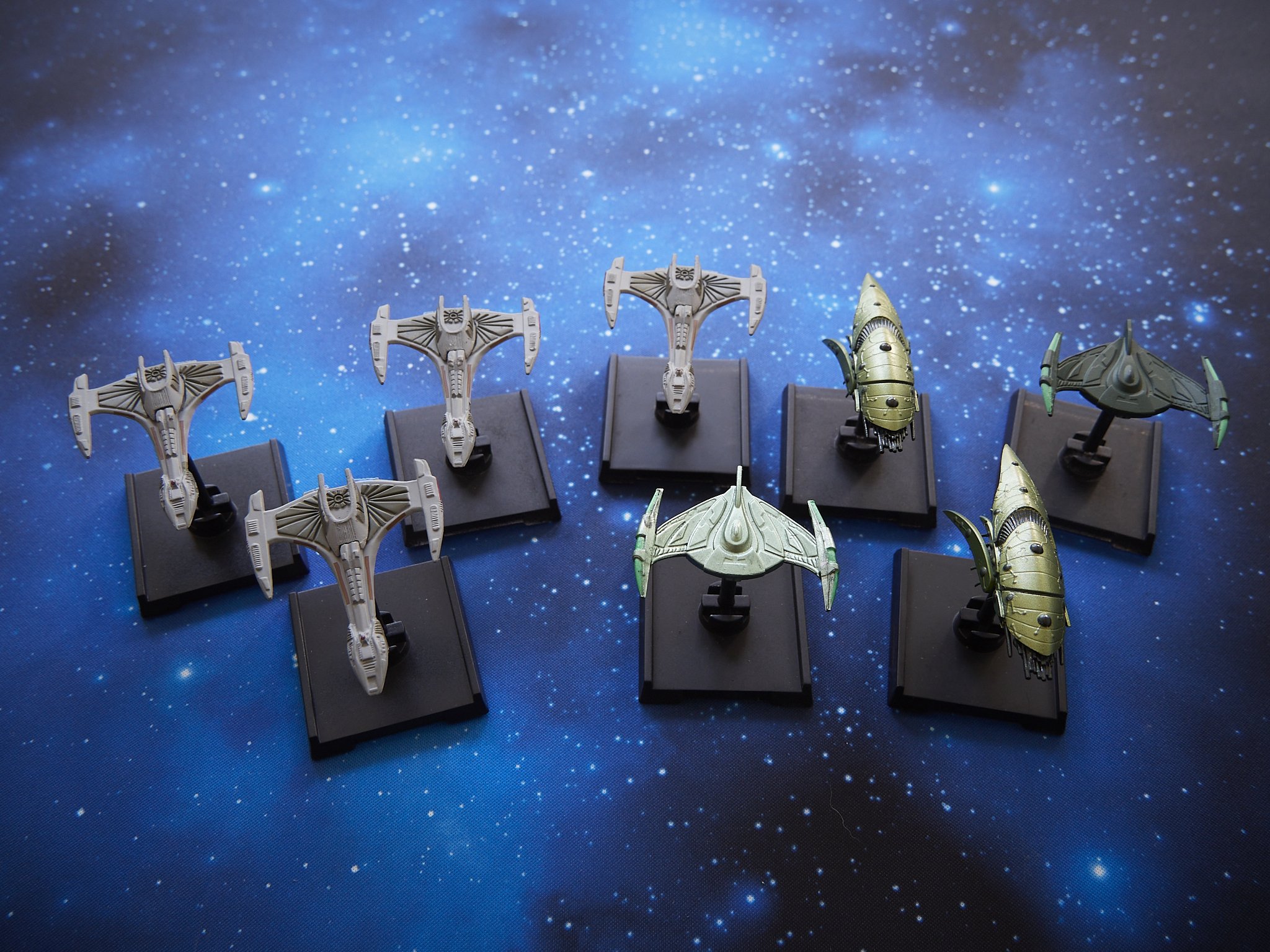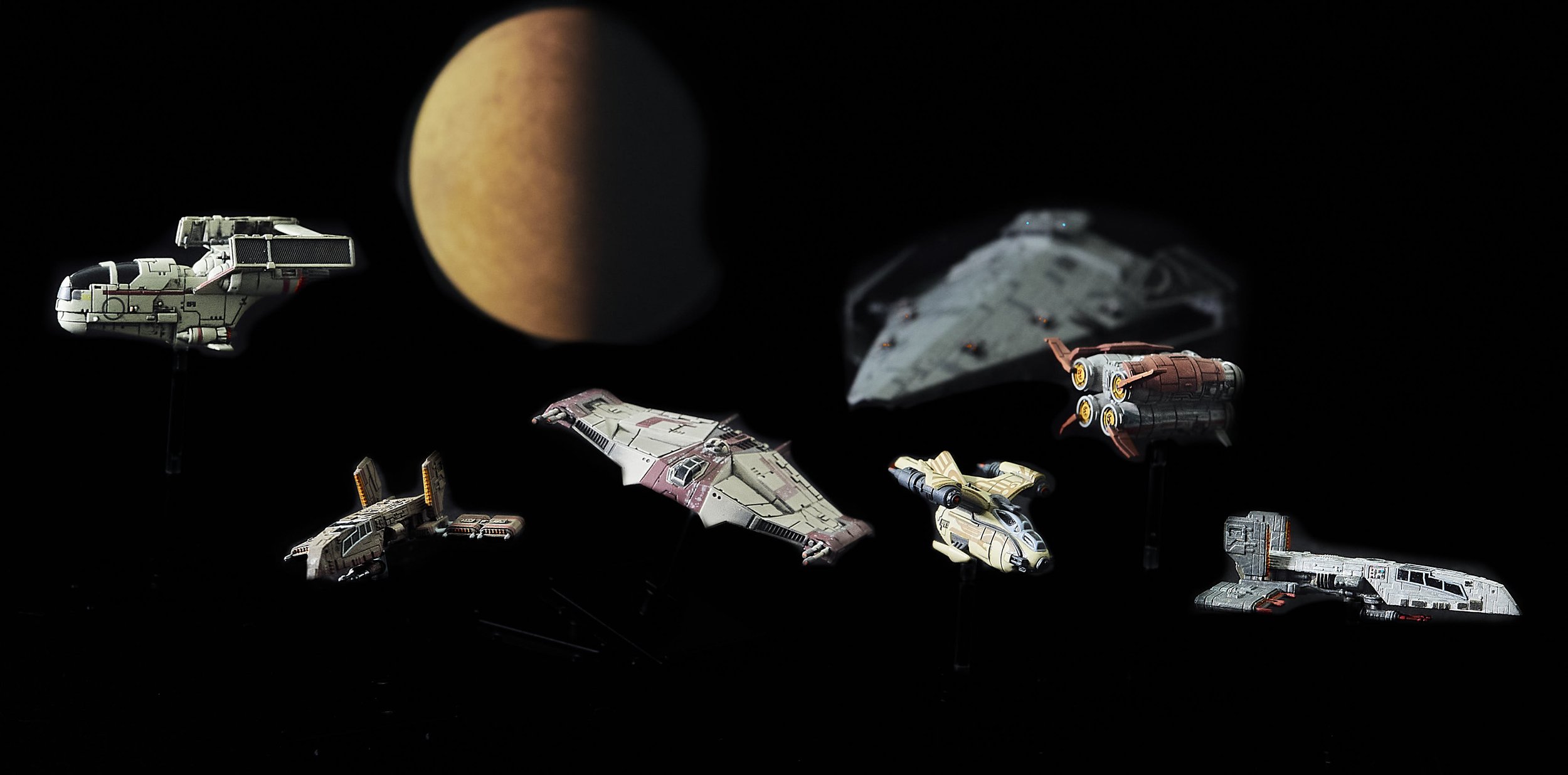Now we come to the “Big guns”.
The later series' are split into two scale classes, “Skirmish” (Voyager and DS9) and “Battle” (TNG, Dominion war). This is for making sense of the highy exaggerated scales in these ranges and to show the quite different feel the two scales have. I just cannot handle the 890m Scimitar facing off against a 15m Delta flyer (the models are only about 1:10 apart) on the table. Even taking gaming abstractions into account, they just look ridiculous. Also, the two scales play differently so doing them separately seems right.
many upgrades can be often be used in either (though not always), so there is great depth of options.
TNG
Battle Scale
The Federation. This is a massive fleet coming in at over 300pts with generic ships. 3 Galaxy class, 1 Sovereign, 2 Nebula, the Promethius, 3 older Excelsiors, an Akira, Constellation and 2 Attack Fighter squadrons (as squadrons each). It goes without saying, there are a ton of upgrades as well with several Picards, Rikers etc and a ton of weapons and tech. Scale is a little vague here, especially with the Oberth and Akira, but they slip in-just, simply because of generally unclear actual size perceptions and their roles in the series. The Defiant, Voyager, Equinox however, do not. The little Constellation is great to add a feeling of scale.
Romulan/Reman. The amazing Scimitar, 3 fighter swarms (represent squadrons), 3 D’Deridex, 2 Valdore make for a tough fleet with a ton of upgrades. Hypothetical Reman control is one option, or as the enemy is another, or just fielding the regular Romulans is still pretty strong.
The Dominion allied fleet. The Jem’hadar have 3 battleships, 2 Battle cruisers, the Breen 3 Cruisers and the Cardassians 2 Keldons and 3 Galors, with a Dreadnaught and 3 fighter wings for depth. At a minimum of about 400 pts, even the full Federation fleet needs some help. If split up (Cardassian separate), they are each capable on their own and can give each other a scare. The little patrol ships are kept for the skirmish scale.
The Klingons are at thier strongest, if least interesting in this group. a single Negh’Var commands 4 Vor’Cha, 3-4 K’Vort (the big BoP), and a few D-7’s from the reserve if needed. Their full Klingon fleet is a match for the Romulan/Remans, close to the Feds and even the Borg.
The Borg. Coming in at 250 pts just for generic ships, seems a little under done when you are actually facing a Queen vessel, 3 Spheres, a Tac Cube, a Scout and the Soong vessel. Regeneration and Drones make for interesting tactical choices and this strong fleet is competitive against all comers with the exception of………
Species 8742. The Borg hate these guys, but my fleet of 4 Bioships is not strong enough to take them all on. Point for point though, these guys beat out the Borg as they are ideally suited to combat them and are another interesting option against the other fleets.
Ferengi. A late inclusion, I have three ships for this faction and the extra card pack. Maybe a minor, unreliable ally?
This is really the “big batlle” game, often played without damage cards (just hull hits) and with base ship types only for big fights. It ideally suits solo play using cards for activation sequence. Any single faction can be strong, several fleets allied are monstrous and a yet to be played head to head game (Borg and Dominion vs all comers?) is beaconing.
DS9/TNG
Skirmish
Apart from the Dominion war, much of DS9 was small scale and so are the ships. Many upgrades from this and the battle set can be shared, meaning upgrade options far outnumber the ships available.
Federation. The Federation get 2 Defiant class (unfortunately not the Valiant, but an ISS ring-in), the Robinson-possibly up to 3 captured ships, 2 Nova class, the dominant Intrepid class, Oberth, Akira and 2 Attack Fighters (as wings). The Oberth and Akira feel better scaled here, but either option works. Still the strongest fleet by far, they have variety and options.
Up to three of the patrol ships could be pressed into service as Feds.
Dominion. The Dominion fleet is a clutch of up to 4 patrol vessels and 3 Cardassian fighter squads. Solid, is the word here, not exciting. These guys also benefit from a huge backlog of characters from the larger scale.
Bajoran. The second biggest single faction, a Scout leads out 4 Interceptors and the Lightship. The last is a scenario driver, but adds some good upgrades and a little colour to the table.
Marquis. The Marquis can field 3 raiders which is barely competitive against the other factions, but their hit and run underdog status suits this. If the Voyager linked crew are used, they get even better.
Romulan/Reman. Combined, this is a decent swarm of 3 fighter flights with 4 scout/science ships and a few nasty tricks. I have fattened it up with some excess upgrades from the larger scale fleet.
A couple of a near endless supply of B’Rel BoP available (seems like most factions have one somewhere), The Romulans have managed to provide 4 (!) different paint jobs for their scout/science ship, but their scary little fighters are uniformly stealth-black. The Fegengi have another Shuttle coming and their own BoP.
The Ferengi. Not a huge fan of these guys and I felt scatterred personalities through the other factions and the Shuttle expansion could represent them well enough. In the “battle” scale game I felt it would have been hard to build up a competitive fleet and did not really want to, but at this scale, the shuttle is another good scenario driver and the upgrades in this one pack are legion! It has now been joined by a B’Rel and second shuttle.
Update; bought more mainly because in a brain fade moment I bought the expansion card pack (thought it was Vulcan!?) and because I already had a shuttle, I went looking for the Kreetcha to use it. I found a decently priced Ferengi boxed set (and the Kreetcha). I now have 2 Shuttles, 3 Marauders and a Bird of Prey with the extra card pack. So much for not wanting to do these guys!
Klingon. The smaller B’Rel BoP is a monster at this scale. Hitting as hard as the Intrepid class, moving like the Defiant, but much cheaper than either, which means the Klingon player can field a decent 100pt fleet with some depth and real punch.
Borg. Throwing the Borg in seems a bit much at this scale, but my single Tac cube as an oversized (correctly scaled?) scout, would put the wind up most of these fleets.
Species 8742. Same goes here. Two Bioships would be a match for most, and 4 could wipe the floor with even the full Fed list.
ISS. A theoretical 2-3 ship list (using Fed dials). Not sure here, but at least I picked up a second Defiant class.
Much smaller and cheaper fleets than the “Battle” option, this is a great scenario space and it has Sisko for the Feds, some of the Voyager crew as Marquis the rest potentially on the Voyager with Worf as a Klingon or Fed!
Voyager
Skirmish
Federation (aka Delta quadrant alliance). The Voyager on her own is a strong ship (always played as named), but fights with just her are predictable and single faceted, even with a ton of upgrade available. If some hypotheticals are applied, the Federation presence becomes a “motley fleet” dynamic, a little like Battlestar Galactica. The Delta Flyer (or two?), Dauntless taken on as an ally, a more open and honest Equinox, a repaired Val Jean, even a long lost D-7 Klingon, all offer possibilities to grow the fleet (The Voyager and any 2 others makes a good 100pt fleet).
The Delta fleet could theoretically be this big. More repainting of Kazons, probably the dull orange of the top right raider. Scaling is still an issue, but bearable.
Kazon. The poor Kazon, not even of interest to the Borg, can field 1 Predator and 3 raiders. This is actually pretty tough for a single dimensional fleet, giving the Kremin or Hirogens a run.
Hirogan. I have 4 hunters and the extra card expansion. The Hirogens are now a match for the Voyager fleet or even another allied ship.
The gorgeous Hyrogen wins the “most fragile” award. Just after I glued on a wing spar for this shoot, I noticed another had lost a top bracket. Still nice though. The Kremin have two ships for depth and they came with two captains. A token Sp 8742 ship is harbinger of a full fleet of 4 if wanted.
Kremin. I bought 2 time ships to make them a viable faction and make the most of the two captains. Not yet put them through their paces, but interesting potential and cool models. You can just squeak a 90pt fleet out of them.
Species 8742 gets a special mention here as this is their origin series. Two make for a tough match up for most and 4 are probably too much even for the full hypothetical Fed fleet. They can take on the Borg though with the same dynamic as the TNG “battle” set, so some type of big battle game is possible.
The Borg are fully developed and to some extent de-clawed/mystified in Voyager. Even a little bit is still too much for Voyager alone, but with the Delta Flyer or another ally, a single Sphere can be beaten. Used sparingly, they are once again the “big bad” of the Delta Quadrant and scenario options are many.
Another favourite and the ships are generally well scaled and presented. The Vidiians were avoided (not a fan), but otherwise the Delta Quadrant is a full and lethal environment. 100pt squads usually top out your options, but then again, Klingons and Romulans are present in small numbers, even the Dominion might have a look in.




































